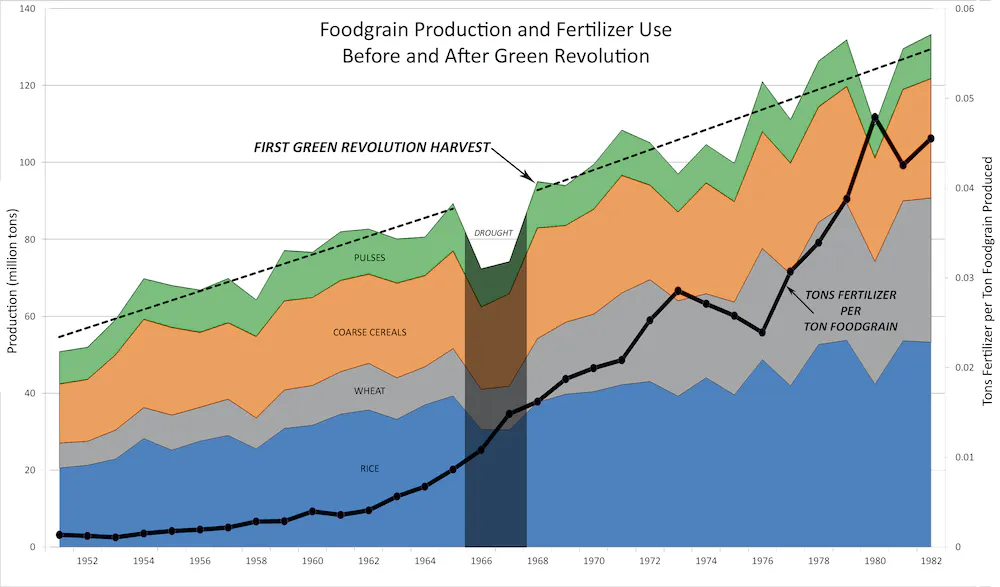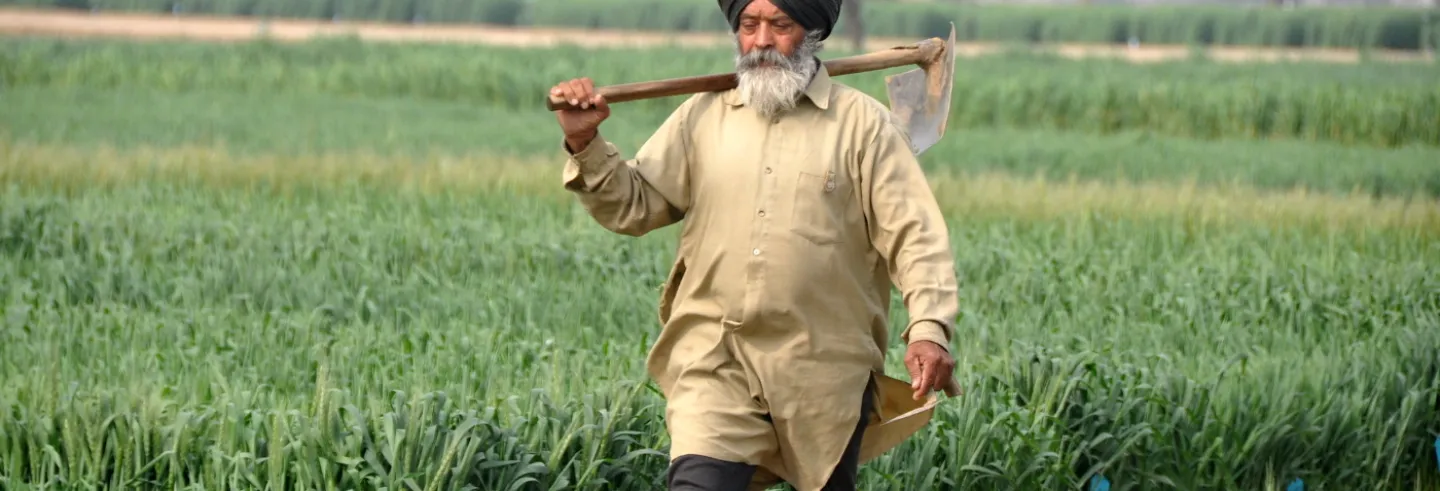Feeding a growing world population has been a serious concern for decades, but today there are new causes for alarm. Floods, heat waves and other weather extremes are making agriculture increasingly precarious, especially in the Global South.
The war in Ukraine is also a factor. Russia is blockading Ukrainian grain exports, and fertiliser prices have surged because of trade sanctions on Russia, the world’s leading fertiliser exporter.
Amid these challenges, some organisations are renewing calls for a second Green Revolution, echoing the introduction in the 1960s and 1970s of supposedly high-yielding varieties of wheat and rice into developing countries, along with synthetic fertilisers and pesticides. Those efforts centred on India and other Asian countries; today, advocates focus on sub-Saharan Africa, where the original Green Revolution regime never took hold.
A wave of new analysis has spurred a critical rethinking of what Green Revolution-style farming really means for food supplies and self-sufficiency.
But anyone concerned with food production should be careful what they wish for. In recent years, a wave of new analysis has spurred a critical rethinking of what Green Revolution-style farming really means for food supplies and self-sufficiency. As I explain in my book, The Agricultural Dilemma: How Not to Feed the World, the Green Revolution does hold lessons for food production today – but not the ones that are commonly heard.
Events in India show why.
A triumphal narrative
There was a consensus in the 1960s amongst development officials and the public that an overpopulated Earth was heading toward catastrophe. Paul Ehrlich’s 1968 bestseller, The Population Bomb, famously predicted that nothing could stop “hundreds of millions” from starving in the 1970s. India was the global poster child for this looming Malthusian disaster. Its population was booming, drought was ravaging its countryside and its imports of American wheat were climbing to levels that alarmed government officials in India and the U.S.
Paul Ehrlich’s 1968 bestseller, 'The Population Bomb', famously predicted that nothing could stop “hundreds of millions” from starving in the 1970s. India was the global poster child for this looming Malthusian disaster.
Then, in 1967, India began distributing new wheat varieties bred by Rockefeller Foundation plant biologist Norman Borlaug, along with high doses of chemical fertiliser. After famine failed to materialise, observers credited the new farming strategy with enabling India to feed itself.
Borlaug received the 1970 Nobel Peace Prize and is still widely credited with “saving a billion lives.” Indian agricultural scientist M.S. Swaminathan, who worked with Borlaug to promote the Green Revolution, received the inaugural World Food Prize in 1987. Tributes to Swaminathan, who died on 28 September, 2023, at age 98, have reiterated the claim that his efforts brought India “self-sufficiency in food production” and independence from Western powers.
Debunking the legend
The standard legend of India’s Green Revolution centres on two propositions. First, India faced a food crisis, with farms mired in tradition and unable to feed an exploding population; and second, Borlaug’s wheat seeds led to record harvests from 1968 on, replacing import dependence with food self-sufficiency.
Recent research shows that both claims are false.
India was importing wheat in the 1960s because of policy decisions, not overpopulation. After the nation achieved independence in 1947, Prime Minister Jawaharlal Nehru prioritised developing heavy industry. U.S. advisers encouraged this strategy and offered to provide India with surplus grain, which India accepted as cheap food for urban workers. Meanwhile, the government urged Indian farmers to grow non-food export crops to earn foreign currency. They switched millions of acres from rice to jute production, and by the mid-1960s India was exporting agricultural products.
Borlaug’s miracle seeds were not inherently more productive than many Indian wheat varieties. Rather, they just responded more effectively to high doses of chemical fertiliser. But while India had abundant manure from its cows, it produced almost no chemical fertiliser. It had to start spending heavily to import and subsidise fertiliser.
Once India’s 1965–67 drought ended and the Green Revolution began, wheat production sped up, while production trends in other crops like rice, maize, and pulses slowed down.
India did see a wheat boom after 1967, but there is evidence that this expensive new input-intensive approach was not the main cause. Rather, the Indian government established a new policy of paying higher prices for wheat. Unsurprisingly, Indian farmers planted more wheat and less of other crops. Once India’s 1965–67 drought ended and the Green Revolution began, wheat production sped up, while production trends in other crops like rice, maize, and pulses slowed down. Net food grain production, which was much more crucial than wheat production alone, actually resumed at the same growth rate as before.
But grain production became more erratic, forcing India to resume importing food by the mid-1970s. India also became dramatically more dependent on chemical fertiliser.

According to data from Indian economic and agricultural organisations, on the eve of the Green Revolution in 1965, Indian farmers needed 8 kilograms of fertiliser to grow an average ton of food. By 1980, it took 44 kilograms. So, India replaced imports of wheat, which were virtually free food aid, with imports of fossil fuel-based fertiliser, paid for with precious international currency.
India replaced imports of wheat, which were virtually free food aid, with imports of fossil fuel-based fertiliser.
Today, India remains the world’s second-highest fertiliser importer, spending $17.3 billion in 2022. Perversely, Green Revolution boosters call this extreme and expensive dependence “self-sufficiency.”
The toll of ‘green’ pollution
Recent research shows that the environmental costs of the Green Revolution are as severe as its economic impacts. One reason is that fertiliser use is astonishingly wasteful. Globally, only 17% of what is applied is taken up by plants and ultimately consumed as food. Most of the rest washes into waterways, where it creates algae blooms and dead zones that smother aquatic life. Producing and using fertiliser also generates copious greenhouse gases that contribute to climate change. Excess nutrients are creating dead zones in water bodies worldwide. Synthetic fertiliser is a major source. In Punjab, India’s top Green Revolution state, heavy use of fertilisers and pesticides has contaminated water, soil and food and endangered human health.
There are many ways to pursue less input-intensive agriculture that will be more sustainable in a world with an increasingly erratic climate.
In my view, African countries where the Green Revolution has not made inroads should consider themselves lucky. Ethiopia offers a cautionary case. In recent years, the Ethiopian government has forced farmers to plant increasing amounts of fertilizer-intensive wheat, claiming this will achieve “self-sufficiency” and even allow it to export wheat worth $105 million this year. Some African officials hail this strategy as an example for the continent. But Ethiopia has no fertiliser factories, so it has to import it – at a cost of $1 billion just in the past year. Even so, many farmers face severe fertiliser shortages.
The Green Revolution still has many boosters today, especially amongst biotech companies that are eager to draw parallels between genetically engineered crops and Borlaug’s seeds. I agree that it offers important lessons about how to move forward with food production, but actual data tells a distinctly different story from the standard narrative. In my view, there are many ways to pursue less input-intensive agriculture that will be more sustainable in a world with an increasingly erratic climate.
(This article was first published in The Conversation.)
Glenn Davis Stone is Research Professor of Environmental Science, Sweet Briar College, USA.









